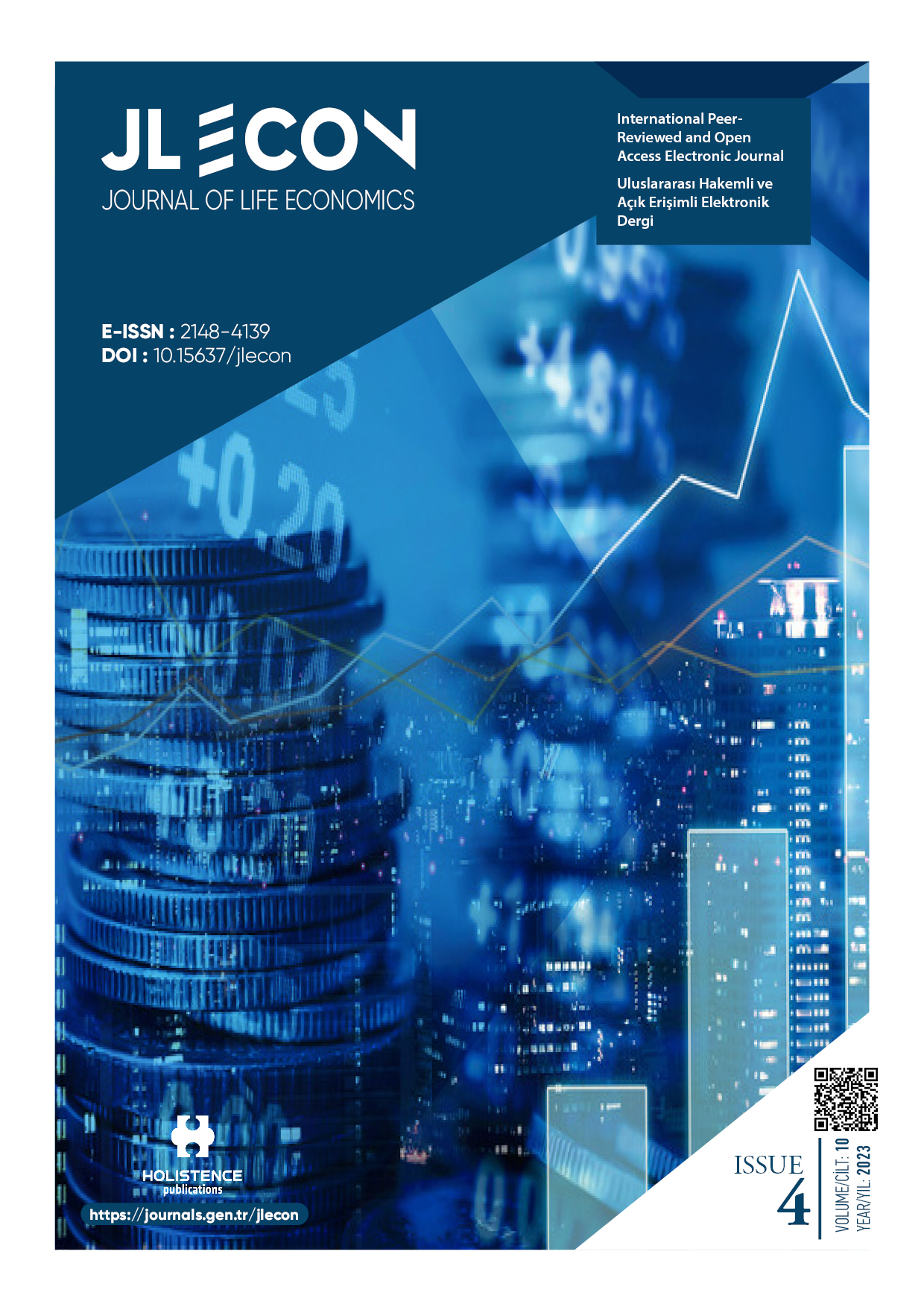The effect of inflation on the budget deficit in Turkiye: Evidence from cointegration test with multiple structural breaks
DOI:
https://doi.org/10.15637/jlecon.2170Keywords:
Inflation, Budget Deficit, Turkiye, Tanzi Effect, Patinkin EffectAbstract
In determining the relationship between the budget deficit and inflation in literature, the effect of the budget deficit on inflation has been widely focused on. Although the impact of inflation on the budget deficit is highly significant, there has been a lack of sufficient research on this matter. There are two different views put forward on this issue. The first of these is the Tanzi effect; argues that an increase in inflation will cause a real decrease in tax revenues and therefore the budget deficit will increase. The opposing view is known as the Patinkin effect and suggests that the budget deficit will decrease because inflation will reduce real public expenditures. In this study, the effect of inflation on the budget deficit was investigated for the period 1960 2022 in Turkiye. Considering that the data period may contain many structural breaks, Carrion-i-Silvestre unit root test and Maki cointegration test were used. The years 1995, 2002, 2007, 2011 and 2018 were determined as the break dates. According to the results, the inflation rate has an increasing effect on the budget deficit in the period when there is no break. The overall result did not change when the effect of breaks was included. With these findings, it can be said that the Tanzi effect is more dominant in Turkiye.
Downloads
References
ABDİOĞLU, Z. & TERZİ, H. (2009). Enflasyon ve bütçe açıkları ilişkisi: Tanzi ve Patinkin etkisi. Atatürk Üniversitesi İktisadi ve İdari Bilimler Dergisi, 23(2), 195-211.
AKÇAY, O. C., ALPER, C. E. & ÖZMUCUR, S. (1996). Budget deficit, money supply and inflation: Evidence from low and high frequency data for Turkey. Boğaziçi Universtiy Research Papers, ISS/EC-1996-12.
AKÇAY, O. C., ALPER, C. E. & ÖZMUCUR, S. (2001). Budget deficit, inflation and debt sustainability: Evidence form Turkey (1970-2000). Boğaziçi Universtiy Research Papers, ISS/EC-2001-12.
ALPER, F. O. (2018). Türkiye’de Bütçe Açığı, Para Arzı ve Enflasyon Arasındaki İlişkinin İncelenmesi: 1971-2016 Dönemi. Business and Economics Research Journal, 9(4), 799-810.
ALTINTAŞ, H., ÇETİNTAŞ, H. & TABAN, S. (2008). Türkiye’de bütçe açığı, parasal büyüme ve enflasyon arasındaki ilişkinin ekonometrik analizi: 1992–2006. Anadolu University Journal of Social Sciences, 8(2), 185-208.
ARJOMAND, M., EMAMİ, K. & SALİMİ, F. (2016). Growth and Productivity: The Role of Budget Deficit in the MENA Selected Countries. Procedia Economics and Finance, 36, 345-352.
BAI, J. & PERRON, P. (1998). Estimating and testing linear models with multiple structural changes. Econometrica 66, 47–78.
BAI, J. & PERRON, P. (2003). Computation and analysis of multiple structural change models. Journal of Applied Econometrics, 18, 1–22.
BANGURA, A., TARAWALİE, A. B., FOFANAH, L. & MACARTHY, S. (2016). Macroeconomic Determinants of Budget Deficit: Evidence from Sierra Leone. International Journal of Economic Perspectives, 10(1), 5-13.
BARIŞIK, S. & KESİKOĞLU, F. (2006). Türkiye’de bütçe açıklarının makroekonomik değişkenler üzerine etkisi (1987-2003 VAR, etki-tepki analizi varyans araştırması). Ankara Üniversitesi SBF Dergisi, 61(4), 59-82.
BAYIR, M. & GÜVENOĞLU, H. (2020). The Analysis of Relationship Between The Money Supply, Budget Deficit and Inflation in Turkey: 2009-2019. ICOAEF’20, VII International Conference on Applied Economics and Finance & Extended with Social Sciences, 186-197.
BAYRAK, M. & KANCA, O. C. (2013). Türkiye’de 1970-2011 yılları arasında oluşan ekonomik ve siyasi gelişmelerin seyri. Akademik Bakış Dergisi, 35, 1-20.
BEDİR, S. & TURAL A. (2014). Bütçe Açığı ve Enflasyon: Türkiye İçin Bir Sınır Testi Yaklaşımı. International Conference on Eurasian Economies, 915, 1-9.
BRIMA, S. & MANSARAY-PEARCE, E. A. (2015). Budget Deficit and Macroeconomic Variables in Sierra Leone: an Econometric Approach. Journal of Economics and Sustainable Development, 6(4), 38-51.
BURGAÇ ÇİL, A. & DÜLGER, F. (2017). İstikrarlılık ve Eşbütünleşme Testleri ile Satın Alma Gücü Paritesi Hipotezinin Türkiye Ekonomisi için Sınanması. Gazi Üniversitesi İktisadi ve İdari Bilimler Fakültesi Dergisi, 19 (3), 998-1020.
CARRION-i-SILVESTRE, J. L., KIM, D & PERRON, P. (2009). GLS-Based Unit Root Tests with Multiple Structural Breaks Under Both the Null and the Alternative Hypotheses. Econometric Theory, 25, 1754-1792.
CATAO, L. A. & TERRONES, M. E. (2005). Fiscal Deficits and Inflation. Journal of Monetary Economics, 52(3), 529-554.
CEYHAN, M. S. & YILDIZ, K. S. (2017). Bütçe Açıkları Belirleyicilerinin Ekonometrik Analizi: Türkiye Uygulaması (2006-2015). USOBED Uluslararası Batı Karadeniz Sosyal ve Beşeri Bilimler Dergisi, 1(1), 21-35.
DAĞ, M. & KIZILKAYA, F. (2019). Bütçe Açığı ile Enflasyon İlişkisi: Türkiye Üzerine Bir Uygulama. İktisadi Yenilik Dergisi, 6(2), 76-85.
DEVAPRİYA, K. P. N. T. N. & ICHİHASHİ, M. (2012). How does the budget deficit affect inflation in Sri Lanka. IDEC discussion paper, Hiroshima University. 1-38.
DOĞRU, B. (2014). Yüksek enflasyon dönemlerinde bütçe açığı ve enflasyon arasında nedensellik ilişkisi var mıdır? 1978-2002 dönemi Türkiye örneği. Eskişehir Osmangazi Üniversitesi İİBF Dergisi, 9(1), 113-129.
EGELİ, H. (1999). Gelişmekte Olan Ülkelerde Bütçe Açıkları, Süleyman Demirel Üniversitesi İ.İ.B.F. Dergisi, 4(2), 293-303.
ELLİOTT, G., ROTHENBERG, T.J. & STOCK, J.H. (1996). Efficient tests for an autoregressive unit root. Econometrica, 64(4), 813-836.
ERDİL ŞAHİN, B. (2019). Analysis of the Relationship Between Inflation, Budget Deficit and Money Supply in Turkey by ARDL Approach: 1980-2017. Journal of Life Economics, 6(3), 297-306.
FAVERO, C. A. & GIAVAZZI, F. (2004). Inflation Targeting and Debt: Lessons from Brazil. NBER Working Paper Series, 10390.
GEORGANTOPOULOS, A. G. & Tsamis, A. D. (2011). The Macroeconomic Effects of Budget Deficits in Greece: A VAR-VECM Approach. International Research Journal of Finance and Economics, 79, 156-166.
GÜNAYDIN, İ. (2001). Türkiye’de kamu kesimi açıkları ve enflasyon. İktisat İşletme ve Finans Dergisi, 16(181), 62-77.
GÜNAYDIN, İ. (2004). Bütçe açıkları enflasyonist midir? Türkiye üzerine bir inceleme. Dokuz Eylül Üniversitesi Sosyal Bilimler Enstitüsü Dergisi, 6(1), 158-181.
HANSEN, B. E. & PHILLIPS, P. C. B. (1990). Estimation and Inference in Models of Cointegration: A Simulation Study. Advances in Econometrics, 8, 225-248.
HONDROYIANNIS, G. & PAPAPETROU, E. (1997). Are budget deficits inflationary? A cointegration approach. Applied Economics Letters, 4(8), 493-496.
ISHAQ, T., & MOHSİN, H. M. (2015). Deficits and inflation: Are monetary and financial institutions worthy to consider or not? Borsa Istanbul Review, 15(3), 180-191.
İPEK, E. & AKAR, S. (2016). Bütçe Açığı ve Enflasyon Arasındaki İlişki: Türkiye İçin Ampirik Bir Analiz. Marmara Üniversitesi İktisadi ve İdari Bilimler Dergisi, 38(2), 167-189.
JALIL, A., TARIQ, R. & BIBI, N. (2014). Fiscal Deficit and Inflation: New Evidences From Pakistan Using A Bounds Testing Approach. Economic Modelling, 37, 120-126.
KAPETANIOS, G. (2005). Unit-root testing against the alternative hypothesis of up to m structural breaks. Journal of Time Series Analysis, 26, 123–133.
KARADENİZ, Y. (2022). Enflasyon ve Bütçe Açığı Arasındaki Kuadratik İlişki: Türkiye Örneği. Sayıştay Dergisi, 33 (125), 291-309.
KAYA, M. G. & ÖZ, E. (2016). Enflasyon, Bütçe Açığı ve Para Arzı İlişkisinin Türkiye Ekonomisi Açısından Değerlendirilmesi: 1980-2014 Dönemi. Yönetim ve Ekonomi, 23(3), 639-651.
KOYUNCU, A. F. T. (2014). Causality network between budget deficit, money supply and inflation: An application to Turkey. International Journal of Business and Social Science, 5(10).225-235.
MAKİ, D. (2012). Tests for Cointegration Allowing for an Unknown Number of Breaks. Economic Modelling, 29(5), 2011-2015.
MARAŞ, G. & DUMRUL, C. (2019). Türk ekonomisinde bütçe açığı ve enflasyon ilişkisinin sınır testi yaklaşımı ile eş-bütünleşme analizi. Erciyes Üniversitesi İktisadi ve İdari Bilimler Fakültesi Dergisi, 54, 314-342.
METİN, K. (1995). An integrated analysis of Turkish inflation. Oxford Bulletin of Economics and Statistics, 57(4), 513-533.
METİN, K. (1998). The relationship between inflation and the budget deficit in Turkey. Journal of Business and Economic Statistics, 16(4), 412-422.
NARAYAN, P. K., NARAYAN, S. & PRASAD, A. D. (2006). Modeling the relationship between budget deficit, money supply and inflation in Fiji. Pacific Economic Bulletin, 21(2), 103-116.
NGUYEN, V. B. (2015). Effects of fiscal deficit and money M2 supply on inflation: Evidence from selected economies of Asia. Journal of Economics, Finance & Administrative Science, 20(38), 49-53.
OKTAYER, A. (2010). Türkiye’de bütçe açığı, para arzı ve enflasyon ilişkisi. Maliye Dergisi, 158, 431-447.
ÖRUÇ, E. (2016). Bütçe açıkları enflasyonist etkiye sahip midir? Türkiye üzerine uzun dönemli analiz. Bolu Abant İzzet Baysal Üniversitesi Sosyal Bilimler Enstitüsü Dergisi, 16(1), 1-21.
ÖZGÜN, D. B. (2000). An Empirical Approach to Fiscal Deficits and Inflation: Evidence From Turkey. Hazine Müstesarlıgı, Ekonomik Arastırmalar Genel Müdürlügü, Ankara.
ÖZMEN, M. & KOÇAK, F. İ. (2012). Enflasyon, bütçe açığı ve para arzı ilişkisinin ARDL yaklaşımı ile tahmini: Türkiye örneği. Çukurova Üniversitesi İİBF Dergisi, 16(1), 1-19.
PATINKIN, D. (1993). Israel’s stabilization program of 1985, or some simple truths of monetary theory. Journal of Economic Perspectives, 7(2), 103-128.
PERRON, P. & QU, Z. (2006) Estimating restricted structural change models. Journal of Econometrics, 134, 373-399.
STOCK, J.H. (1999). A class of tests for integration and cointegration. In Cointegration, Causality, and Forecasting: A Festschrift for Clive W.J. Granger, 135-167. Oxford University Press.
TANZI, V. (1978). Inflation, real tax revenue, and the case for inflationary finance: Theory with an application to Argentina. IMF Staff Papers, 25, 417-451.
TIWARI, A. K., BOLAT, S. & KOÇBULUT, Ö. (2015). Revisit the Budget Deficits and Inflation: Evidence from Time and Frequency Domain Analyses. Theoretical Economics Letters, 5, 357-369.
YARAŞIR TÜLÜMCE, S., AKÇAY, F. & YAVUZ, E. (2021). Tanzi ve Patinkin Etkisinin Panel Veri Analizi: Euro Bölgesi Ülkeleri. Ekonomi, Politika & Finans Araştırmaları Dergisi, 6(Özel Sayı), 97-118.
ZONUZI, J. M., POURVALADI, M. S. H. & FARAJI, N. (2011). The Relationship between Budget Deficit and Inflation in Iran. Iranian Economic Review, 15(28), 117-133.
Downloads
Published
How to Cite
Issue
Section
License
Copyright (c) 2023 Holistence Publications

This work is licensed under a Creative Commons Attribution 4.0 International License.
When the article is accepted for publication in the Journal of Life Economics, authors transfer all copyright in the article to the Holistence Publications.The authors reserve all proprietary right other than copyright, such as patent rights.
Everyone who is listed as an author in this article should have made a substantial, direct, intellectual contribution to the work and should take public responsibility for it.
This paper contains works that have not previously published or not under consideration for publication in other journals.

















